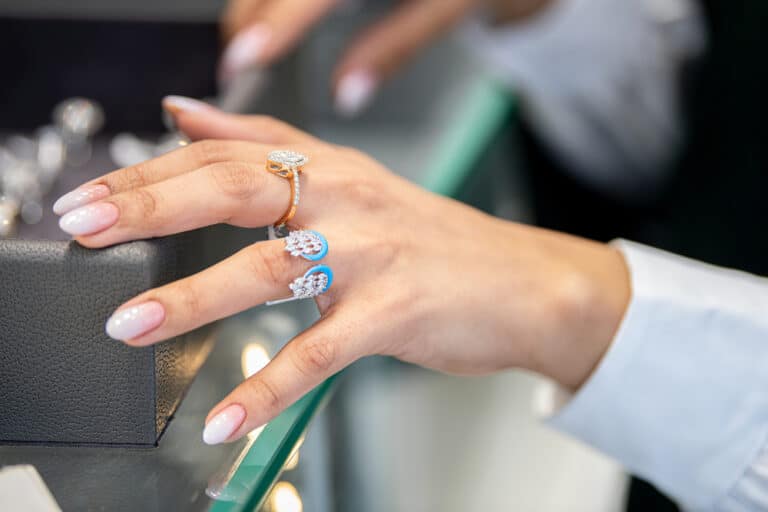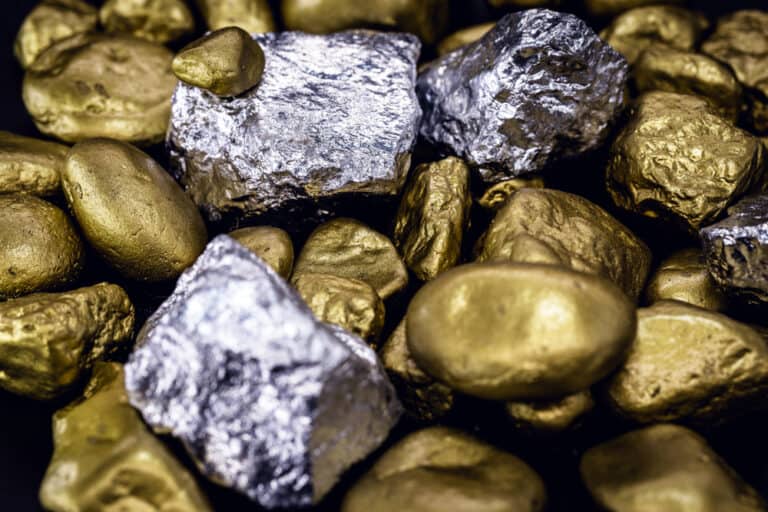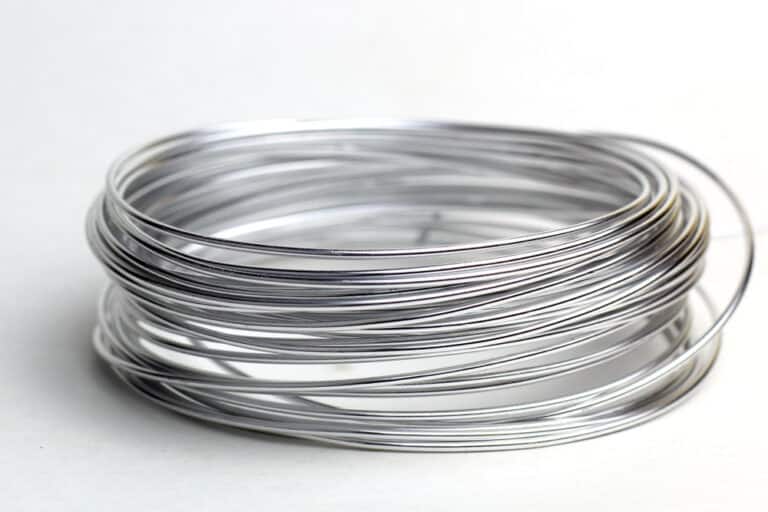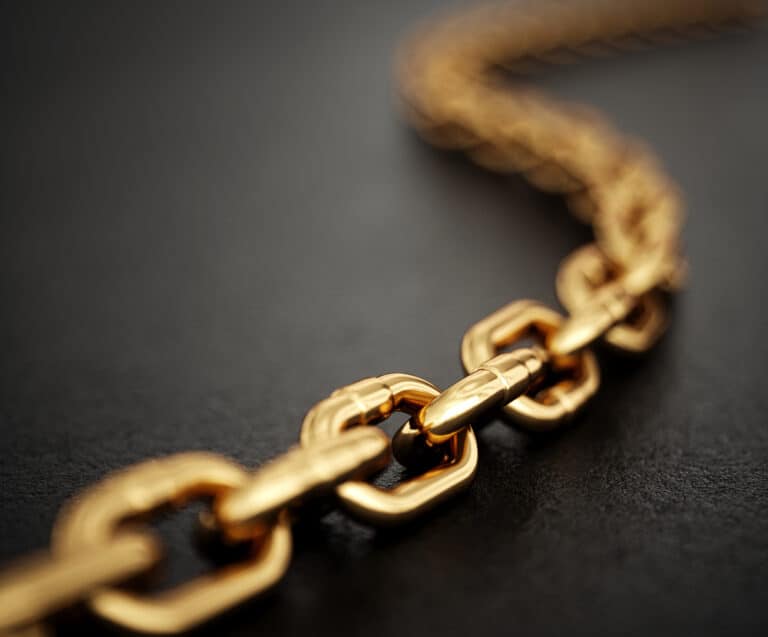You may wonder what it is if you have heard of the term “German silver,” possibly from people speaking in disparaging tones. Is it silver mined or manufactured in Germany, as the name suggests? Or is it something else entirely and utterly different than silver? We compare silver vs. German silver.
Silver is a metallic element found on the periodic table, whereas German silver is an alloy of copper with nickel and, in modern times, zinc. Despite superficial similarities in appearance, they differ in their chemical properties, applications for which people can use them, and value.
While knowing that silver is an element and German silver is an alloy is helpful, if you are unsure of the meaning of these terms, it does not enlighten you much. Moreover, this information does not help you understand the properties and uses of these two metals and how to distinguish them. Let’s take a look.
The Chemical Composition Of Silver Vs. German Silver
Silver is a soft, lustrous, whitish transition element or metal mainly extracted from copper, lead, zinc, and gold refining. It is a valuable precious metal used for jewelry and bullion, in addition to many practical technological uses. It does not often occur as a native metal (in other words, as a metal on its own).
In contrast, German silver is an alloy of copper and nickel, with many modern forms containing zinc. Although a natural ore of these metals, known as baiting or paktong depending on the dialect, was mined in China and smelted into the alloy, the alloy as we know it is the creation of German metallurgists (hence the “German” part of the name).
German silver is called by several other names, such as nickel silver, nickel brass, Maillechort, Argentan, Alpacca (or alpaca), new silver, and albata. Should you see these terms on an item, it does not contain any elemental silver.
The Nature Of Silver As An Element And An Alloy
Because silver is an element, it has the characteristics of an element. You can place it on the periodic table of the elements, with a symbol of Ag, an atomic number of 47, and a standard atomic weight of 107.868. Its atoms have 47 electrons arranged in a configuration similar to its neighbors copper and gold and have metallic bonds that lack covalent character and hence are relatively weak.
These distinct atomic properties account for its characteristic physical and chemical properties, such as being quite soft, extremely malleable, and ductile, and having a classic highly lustrous whitish shiny appearance.
These atomic properties also account for its having extremely high thermal conductivity (one of the highest of any material), and extremely high electrical conductivity, higher than that of copper, while at the same time having lower contact resistance than any other metal.
In practice, when people make objects such as tableware and jewelry of silver, the silver in question is always an alloy, which means it is a mixture of several metallic elements. Silver is alloyed with other metals, making it hard to stand up to frequent use. However, it still contains a large percentage of elemental silver.
For example, sterling silver is 92.5 percent silver and 7.5 percent copper and is marked with the millesimal fineness 925. Silver jewelry is usually 85 to 90 percent silver and 10 to 15 percent copper, while coin silver is 90 percent silver and 10 percent copper.
The Nature Of German Silver As An Alloy
German silver is an alloy. It does not have its symbol, atomic number, or atomic weight, although its constituent elements do.
Copper has the symbol Cu, the atomic number 29, and soft, ductile, malleable, and high electrical and thermal conductivity. Nickel has the symbol Ni, the atomic number 28, and is a hard, ductile metal that resists corrosion. Zinc has the symbol Zn, the atomic number 30, is slightly brittle, and is corrosion resistant.
Although each constituent element of German silver has a distinctive elemental identity (and associated atomic characteristics), we cannot assign a symbol or atomic number to the alloy because it is a mixture.
Nevertheless, this does not mean that German silver does not have distinctive properties. It is hard and durable (corrosion-resistant), which makes it suitable for many practical applications. Unfortunately, long-term exposure of this copper-based alloy to acid foods and liquids leaching copper causes liver toxicity and cirrhosis in the long run. The nickel in it can also cause contact dermatitis.
The Uses Of Silver Vs. German Silver
Now that you know what silver and German silver are, let’s look at their uses.
The Applications Of Silver
Silver is used for coins and bullion, being a valuable investment. Due to its value and beauty, it is used for jewelry, ornaments, cutlery, and tableware (known as silverware). These particular applications are often cheaply replicated with nickel silver.
However, silver’s unique physical and chemical properties mean that it is also used in electrical conductors and solar panels due to its conductivity and in mirrors and window coatings due to its reflectivity. It also finds use as a catalyst for chemical reactions and confectionery (silver balls on cupcakes, for example).
Some silver compounds are used in photography and radiography, and others find medical applications for their microbiocidal effects.
The Applications Of German Silver
German silver is a base metal for electroplating to produce cutlery and tableware, known as EPNS (electroplated nickel silver). It is also used to make coins, and musical instruments such as flutes, saxophones, clarinets, trumpets, and French horns, producing a bright, clear sound. It is used for keys, costume jewelry, zippers, and high-quality equine harness and tack.
It is widely used for plumbing fixtures and marine fittings such as propulsion screws due to their hardness and corrosion resistance and in electrical fittings and heating coils due to their high electrical resistance. Another advantage of this material is its machinability.
Fraudsters and counterfeiters have used nickel silver to fake silver bullion, silver rounds, and Morgan dollars.
How To Distinguish Between Silver And German Silver
To identify genuine silver, look for a stamp that indicates millesimal fineness (925, 900, and 800 are the most common internationally). Be sure the symbol is not a lie – many fakes are on the market nowadays. If you see one of the names listed above for German silver, that is what you are dealing with.
Try putting a piece of ice on the metal in question. If it immediately begins melting, the item will likely be high in elemental silver due to its thermal conductivity.
You can also try chemical tests such as applying bleach to the surface of the metal, which will cause genuine silver to blacken rapidly. However, this will also happen with electroplated nickel silver.
Try gauging the weight of the item. If it seems unusually light for its size, it is probably German silver rather than genuine silver.

Conclusion
While silver and German silver sound similar, they are two completely different metals. Do not be fooled into paying top dollar for a cheap German silver item, thinking that it is genuine silver. German silver could also cause damage to your liver or skin. Buyer beware!
References
- https://www.wikihow.com/Test-Silver
- https://www.ehow.com/info_8745988_german-silver-made.html
- https://en.wikipedia.org/wiki/Nickel_silver
- https://en.wikipedia.org/wiki/Silver
- https://www.marthastewart.com/1541729/how-tell-silver-is-real
- https://www.quora.com/What-is-the-difference-between-German-silver-and-sterling-silver-Does-German-silver-get-tarnished-to-black-How-do-you-store-and-maintain-German-silver-jewellery
- https://www.vedantu.com/question-answer/constituents-of-german-silver-are-a-cu-zn-sn-b-class-12-chemistry-cbse-5f7ff58aae8b8937f8295acb
- https://rauantiques.com/blogs/canvases-carats-and-curiosities/prost-a-history-of-german-silver
- https://www.thesprucecrafts.com/nickel-german-silver-alpaca-149118
- https://ourpastimes.com/difference-german-silver-sterling-silver-8362271.html






